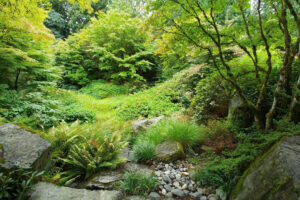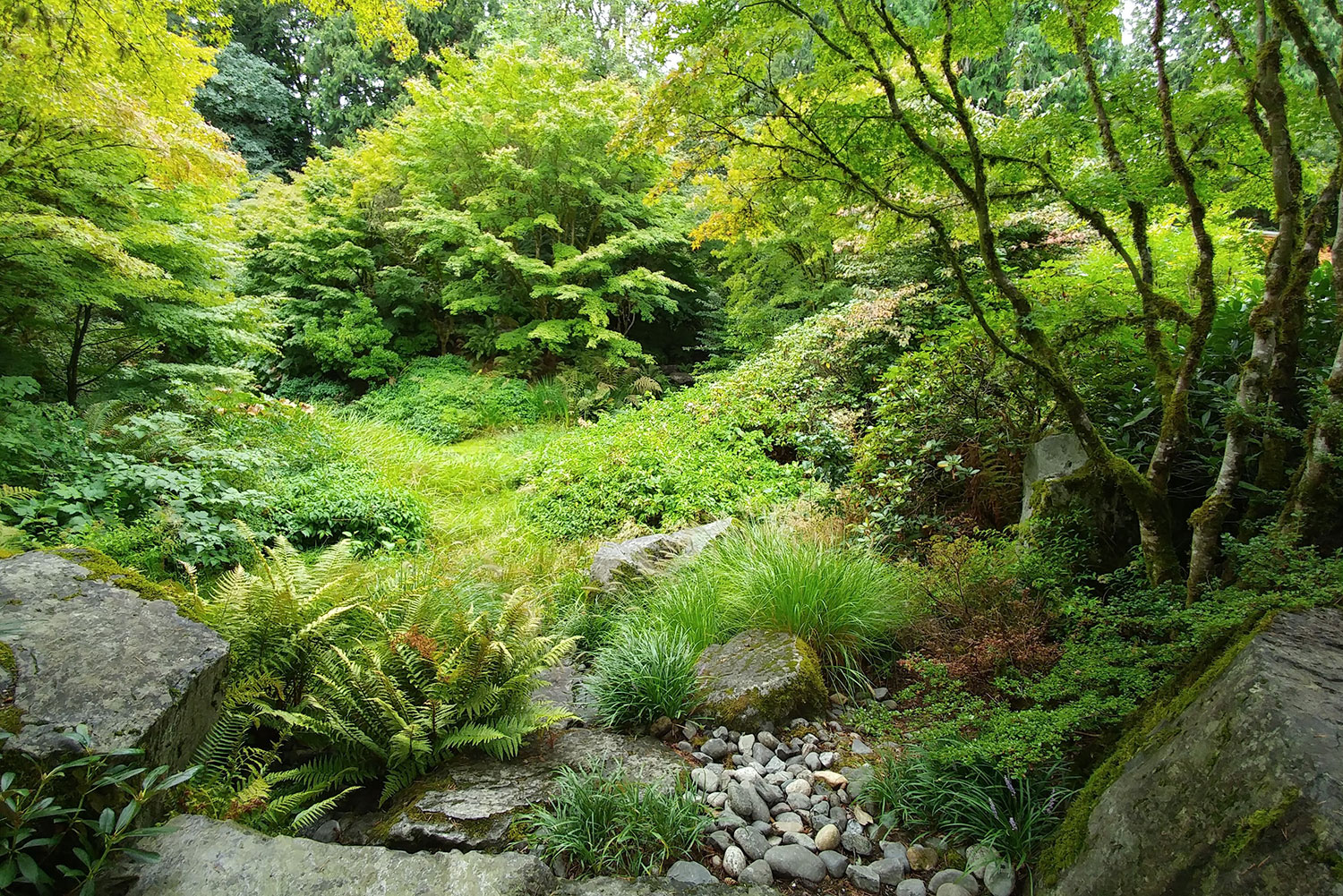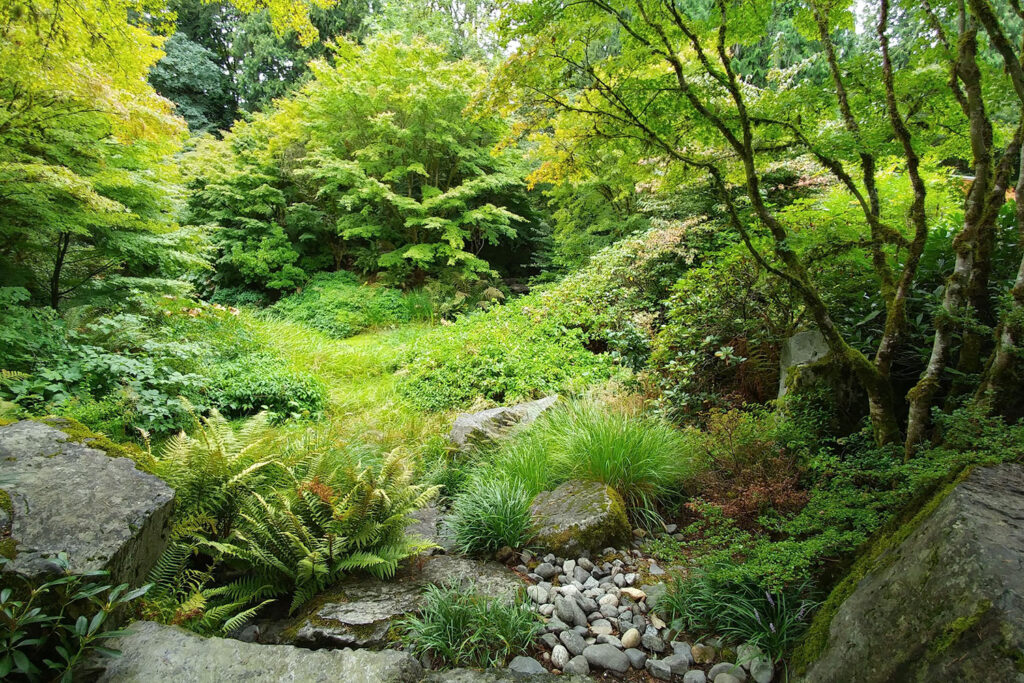 Shade sites can be easy to fill with glorious, season long beauty or they can be finicky and divaesque. There is no one size fits all. This is where observation skills and site knowledge pay big dividends. Light or deep shade, moist or dry soil, compact or loose – mind-boggling combinations.
Shade sites can be easy to fill with glorious, season long beauty or they can be finicky and divaesque. There is no one size fits all. This is where observation skills and site knowledge pay big dividends. Light or deep shade, moist or dry soil, compact or loose – mind-boggling combinations.
Some of the toughest combinations for shade plantings involve extremes, which test any plant’s ability to adjust to conditions outside the norms. Even if all reports indicate plant tolerance, count on that being true in life only after plants have had an opportunity to establish. All plants need some level of soil moisture to establish and thrive. Even hot and dry loving succulents need soil moisture for early root development. Expect to baby any new shade plants until they have a chance to settle in, acclimate, and start to get comfortable in their new home.
Now let’s dig in and figure out conditions specific to a chosen shade planting site. Often used terms like deep shade, partial shade, light shade, and dappled shade are great but what do they mean?
Deep shade is that type of shade that feels refreshing on a very hot, sunny summer day. Think about that feeling of ten degrees of coolness just by walking into it. No rays of sun peek through the tree canopy or pierce the shade thrown by a building. Expect a cool stillness to the air. In the deep shade, there may be impediments to moisture reaching, not only plant root zones but even the top level of the soil.
Partial shade has less impediments to sun and moisture reaching the soil and plants. Light shade is as it sounds, lighter than deep shade. No rays of sunshine poking through with sun and moisture still less available to plants. I love the term dappled shade, as it evokes happiness. Dappled shade will always have sun and moisture able to reach through. When planting in a dappled site, look for plants that are not afraid of a bit of sun.
As with all planting sites, knowledge of soil structure is critical to success. Unless fortunate enough to either be or live with a soil scientist, send a soil sample to a local or state lab. It is one of the best investments any gardener can make to help narrow down site appropriate plants and manage fertility. For a relatively small fee, the sample sent will result in a thorough report detailing soil type, existing fertility, future nutrient needs, and how to achieve desired site goals. Do be diligent in filling out the forms. As with most things, good input will equal a better output.
Both perennials and annuals are great additions to any shady landscape. Mix it up. Use annuals to fill spots that are proving difficult to manage with perennials and vice versa. Unless planting completely aggressive brutes, they will play nicely together. Adding annuals to perennial beds offer an opportunity to spice up existing beds year to year.
Annuals for Shade
- Alocasia cuprea: they like partial shade; beware as the rest of the family prefers full sun
- Begonias: good plants for everything from shade to sun; between the four main types of begonias (cane/angelwing, rex, tuberous, and wax) gardeners should be able to find something to make them happy; after establishment, most begonias will do just fine when ignored
- Caladium: full shade, no direct sunlight; bright leaf color, flowers unimportant to the show; do not place outside until night temps are 65 degrees F or higher; plant tubers deeply to encourage as much leaf development as possible
- Coleus: shade and sun loving; colors will vary, even on one plant, based on light exposure; pick your favorite and run with it, too many from which to choose
- Fuchsia: great shade plants, but most don’t like heat and humidity; a smidge of morning sun is good for them
- New Guinea Impatiens: SunPatiens Series has excellent form and colors and works beautifully in both sun and shade
Perennials for Shade
- Asarum canadense: best in moist, acid, well-drained soils, with heavy shade
- Astilbe x arendsii: spring flowering; “Ellie” white, “Delft Lace” (or “Look at Me”) pink, “Federsee” (good in dry conditions) red, “Chocolate Shogun” deep purple foliage with very light pinkish flowers
- Astilbe biternate: native US astilbe, with yellowish white arching flowers
- Astilbe chinensis “Amber Moon”: summer flowering with interesting foliage; “Purple Candles” has purple flowers with red tones standing close to three feet in height; “Visions” Series
- Astilbe x rosea: summer bloomers; moist conditions necessary
- Athyrium nipponicum “Godzilla”: needs moderately consistent water, rich soil, and deep to partial morning sun
- Bergenia ciliate: requires some winter protection but pretty plant, not too many cultivars available
- Bergenia crassifolia: “Baby Doll” stands about one foot tall, “Pugsley’s Purple” and “Pugsley’s Pink” are the tallest at about two feet
- Brunnera: likes moist shade; plant en masse for great effect; anything with color variations in the leaf tend to be a bit more prone to health and longevity issues but worth planting if you have a moist site
- Convallaria “Touch of Lemon”: partial, moist shade; leaves have a glimmer of yellow along the edges; the flowers have a noticeable citrus scent in addition to the lovely and traditional lily of the valley fragrance
- Galium oderatum: consistent water, partial shade; a lovely groundcover that will quietly fill space
- Hakonechloa: will take everything from full sun to full shade (where they really make a statement) as long as the crown stays dry and the roots stay moist; there are many gorgeous cultivars available
- Helleborus: a shade staple for moist, somewhat shady sites; divide early in spring and only as you must as it takes a few years to rebound
- Heuchera: moist, rich, well-drained soil, partial shade; so many cultivars, so little time
- Lamprocapnos spectabilis “Gold Heart” and “White Gold”: partial shade, moist; will die back in early summer if the soil is allowed to dry out; a great plant for coloring up shade
- Lysimachia nummularia “Aurea”: moist soil, shady; can be slightly invasive but pulls up readily; roots easily wherever it is dropped
- Rodgersia: requires plenty of moisture and at least partial shade; good flowers; big and bold leaves
- Vinca yellow/gold cultivars: provides a brightness to shady, moist areas; yellow/gold leaf cultivars are fun

